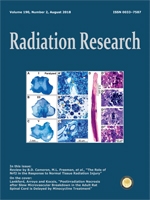We investigated the relationship between significantly different genes of the mitochondria-to-nucleus retrograde signaling pathway (RTG) in H1299 ρ0 cells (mtDNA depleted cell) and compared their radiosensitivity to that of parental ρ cells, to determine the possible intervention targets of radiosensitization. ρ0 cells were depleted of mitochondrial DNA by chronic culturing in ethidium bromide at low concentration. Radiosensitivity was analyzed using clonogenic assay. Western blot was used to analyze the cell cycle-related proteins, serine/threonine kinase ataxia telangiectasia mutant (ATM), ataxia telangiectasia and Rad3-related protein (ATR) and cyclin B1 (CCNB1). The γ-H2AX foci were detected using confocal fluorescence microscopy. RNA samples were hybridized using the Agilent human genome expression microarray. The Kyoto Encyclopedia of Genes and Genomes (KEGG) database was used for Gene Ontology (GO) Consortium and pathway annotations of differentially expressed genes, respectively. The H1299 ρ0 cells were found to be more radioresistant than ρ cells. The ATP production of H1299 ρ0 cells was lower than that of the ρ cells before or after irradiation. Both H1299 ρ0 and ρ cells had higher ROS levels after irradiation, however, the radiation-induced ROS production in ρ0 cells was significantly lower than in ρ cells. In addition, the percentage of apoptosis in H1299 ρ0 cells was lower than in ρ cells after 6 Gy irradiation. As for the cell cycle and DNA damage response-related proteins ATM, ATR and CCNB1, the expression levels in ρ0 cells were significantly higher than in ρ cells, and there were less γ-H2AX foci in the ρ0 than ρ cells after irradiation. Furthermore, the results of the human genome expression microarray demonstrated that the phosphorylated protein levels of the NF-κB/PI3K/AKT2/mTOR signaling pathway were increased after 6 Gy irradiation and were decreased after treatment with the AKT2-specific inhibitor MK-2206 combined with radiation in H1299 ρ0 cells. MK-2206 treatment also led to an increase in pro-apoptotic proteins. In conclusion, these results demonstrate that mtDNA depletion might activate the mitochondria-to-nucleus retrograde signaling pathway of NF-κB/PI3K/AKT2/mTOR and induce radioresistance in H1299 ρ0 cells by evoking mitochondrial dysfunctions.
How to translate text using browser tools
4 June 2018
Mitochondrial Dysfunctions Regulated Radioresistance through Mitochondria-to-Nucleus Retrograde Signaling Pathway of NF-κB/PI3K/AKT2/mTOR
Yuehua Wei,
Lulu Chen,
Hui Xu,
Conghua Xie,
Yunfeng Zhou,
Fuxiang Zhou
ACCESS THE FULL ARTICLE

Radiation Research
Vol. 190 • No. 2
August 2018
Vol. 190 • No. 2
August 2018




